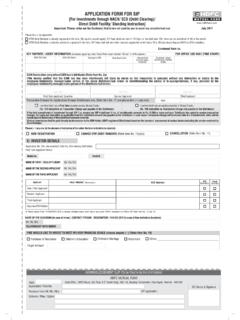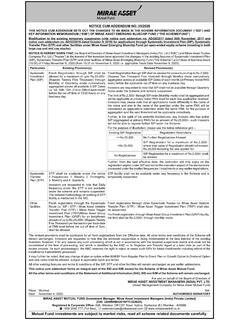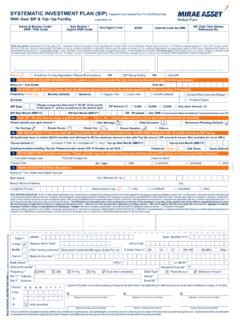Transcription of Sub: Mutual Fund (MCQ Question Bank) Module 1 A ... - RSET
1 TYBFM (Sem VI) Sub: Mutual fund (MCQ Question bank ) Module 1 1. The First player of the Mutual fund industry was_____. A) ICICI MF B) UTI MF C) SBI MF D) LIC MF 2 . UTI Mutual fund was set up in the Year _____. A) 1963 B) 1986 C) 1956 D) 1947 3. _____ Mutual fund company was set up as a joint venture between RBI and Government of India A) UTI MF B) LIC MF C) SBI MF D) ICICI MF 4 Who establishes the Mutual fund in India? A) Securities Exchange Board of India B) Asset Management Company C) Sponsor D) Shareholders 5. In India, AMC must be registered with_____. A) Company s Act, 2013 B) No registration required. C) Securities Exchange Board of India D) Reserve bank of India 6.
2 _____ is a type of investment vehicle consisting of a portfolio of stocks, bonds, or other securities. A) Government Securities B) Mutual Funds C) Derivatives D) Shares 7 The value of one unit of investment in Mutual fund is called the _____. A) Net Asset Value B) Issue value C) Market value D) Gross Asset value 8 _____ regulates the Mutual fund industry in India. A) Reserve bank of India B) Association of Mutual Funds of India C) Securities Exchange Board of India D) State bank of India 9 What is the full form of NAV? A) Net Assessment Value B) National Asset Value C) Net Asset Value D) National Asset variation 10 _____ schemes not exposed to sudden and large movements of funds.
3 A) Fixed maturity plan B) Open-Ended Funds C) Close-Ended Funds D) Interval fund 11 The feature of a Mutual fund , where it spreads the investment in varied stocks and sectors by pooling the funds of various investors, is called as _____. A) Professional Management B) Affordability C) Diversification D) Profit 12 Dividend income received from Mutual in the hands of unit holders A) Fully Taxable B) Fully Exempt C) Partly Exempt D) Partly Taxable 13. Which of the following is not a limitation of Mutual funds? A) No guarantee of return B) Fees and Expenses C) Poor Performance D) Professional Management 14 The Mutual fund industry follows which of the following regulation?
4 A) SEBI ( Mutual fund ) regulations 1996 B) Mutual fund regulation 2004 C) Mutual fund regulation 2003 D) RBI 15 Presently there are _____ AMC in India A) 40 B) 50 C) 44 39 16 A _____ is a trust that pools the savings of a number of investors who share common financial goals. A) Shares B) Mutual Funds C) Government Securities D) Derivatives 17 What are the reasons for economies of scale to the benefit of Mutual funds? A) Large volumes of trade B) Portfolio diversification C) Risk reduction D) Loss 18 _____ are also known as the protectors of the fund and are employed by the fund sponsor. A) Sponsor B) Trustees C) Asset Management Company D) Custodian 19 A minimum start-up capital of about _____is required for open-ended schemes A) 500 million B) 1000 million C) 350 million D) 200 million 20 A minimum start-up capital of about _____is required for close-ended schemes A) 150 million B) 100 million C) 350 million D) 200 million 21 The funds in which units can be purchased only during the initial offer period are called A) Open-Ended Funds B) Close-Ended Funds C) Interval Funds D) Fixed maturity plan 22 The first introduction of Mutual Funds in India occurred in which of the following years?
5 A) 1963 B) 1986 C) 1956 D) 194 23 _____ are considered high-risk funds but also tend to provide high returns. A) Equity Funds B) Money Market Funds C) Balanced or Hybrid Funds D) Debt Funds 24 _____ are funds that invest in company debentures, government bonds and other fixed-income assets. A) Equity Funds B) Money Market Funds C) Balanced or Hybrid Funds D) Debt Funds 25 HDFC Sensex ETF is an example of _____. A) Sector Funds B) Index Funds C) fund of funds D) International funds 26 Nippon India Pharma fund is an example of _____. A) Sector Funds B) Index Funds C) Equity funds D) Global funds 27 AMFI was incorporated on _____. A) 22nd August 1995 B) 12th April 1992 C) 1st April 1935 D) 15th August 1947 28 Which type of fund is more volatile?
6 A) Large-cap funds B) Mid-cap funds C) Small-cap funds D) Hybrid Funds 29 An investor pays a tax on the dividend that he receives from a Mutual fund scheme at A) 10% B) 20% C) 30% D) Tax is not applicable 30 Investors can enter and exit under _____ at any time A) Fixed maturity plan B) Open-Ended Funds C) Close-Ended Funds D) Interval fund 31 The NAV of each scheme should be updated on AMFI's website A) Every Day B) Every month C) Every hour D) Every quarter 32 Mutual fund schemes are first offered to investors through. A) Stock exchange B) New fund Offer C) Initial Public Offer D) AMFI 33 Which of the following banks launched the first Mutual fund in India? A) SBI B) Canara bank C) bank of India D) Indian bank 34.
7 Which of the following organizations is the Mutual fund Market regulator in India? A) SEBI B) RBI C) AMFI D) CIBIL 35 A Mutual fund is owned by _____. A) SEBI B) The Government of India C) AMFI D) All its investors 36 SIP is a _____. A) Method of regular investment B) Name of a Mutual fund C) Brand of a tea stock D) Method of one time investment 37 SIP stands for _____. A) systematic investment plan B) Simple investment plan C) Simplified investment programme D) Single investment plan 38 SWP stands for _____. A) systematic whining plan B) systematic withdrawal plan C) systematic winning plan D) System winning plan 39 Day to day operations of a Mutual fund is handled by A) Asset Management Company B) Sponsor C) Trustee D) Shareholders 40 Mutual funds are constituted in India as _____.
8 A) Trusts B) Limited liability partnership C) Companies D) Non-Government organisations 41 The susceptibility of a Mutual fund s performance to general stock market conditions is known as A) Interest rate risk B) Market risk C) Exchange risk D) Corporate risk 42 The _____ is the market value of the securities that Mutual funds have purchased minus any liabilities per unit. A) Net asset value B) Book value C) Gross asset value D) Net worth value 43 Which payment mode is not applicable while purchasing Mutual fund scheme? A) Cheque B) Demand Draft C) Cash D) Pay Order 44 _____ are an important link between fund managers and investors. A) Trustees B) Asset Management Company C) Custodian D) Registrar And Transfer Agents 45.
9 What is an open-ended Mutual fund ? A) It is the one that has an option to invest in any kind of security B) It has units available for sale and repurchase at all times. C) It has an upper limit on its NAV D) It has a fixed fund size 46 In _____ funds, the money is invested primarily in short-term or very short-term instruments T-Bills, CPs etc. A) Growth funds B) Income funds C) Liquid funds D) Tax-Saving Funds (ELSS) 47 _____ is a method of investing in Mutual funds wherein an investor chooses a Mutual fund scheme and invests a the fixed amount of his choice at fixed intervals. A) systematic Transfer plan B) systematic Withdrawal plan C) systematic investment plan D) systematic Innovative plan 48 Mutual funds in India are permitted to invest in_____ A) Securities B) Securities and gold C) Securities other than real estate D) Securities, gold, real estate is the first time subscription offer for a new scheme launched by the Asset Management Company.
10 A. FFO b. CFO c. IPO d. NFO 50. A Mutual fund is a ..intermediary (like a trust) regulated in India by the SEBI. a. financial b. professional c. physical d. Mental 51. Transaction cost is .. with investment in Mutual Funds. a. high b. low c. very high d. Nil helps to improve the risk return relationship. a. Diversification b. Liquidity c. Professional Management d. tax 53. Open ended funds can be purchased and sold .. a. Anytime during the day b. Only at the beginning of the day c. Only at the end of the day d. Starting of the day 54.. is a facility where investor will invest a fixed amount in a Mutual fund scheme at regular intervals. a. SIP b. SWP c. STP d. SRT allows an investor to withdraw a fixed amount of money periodically.






